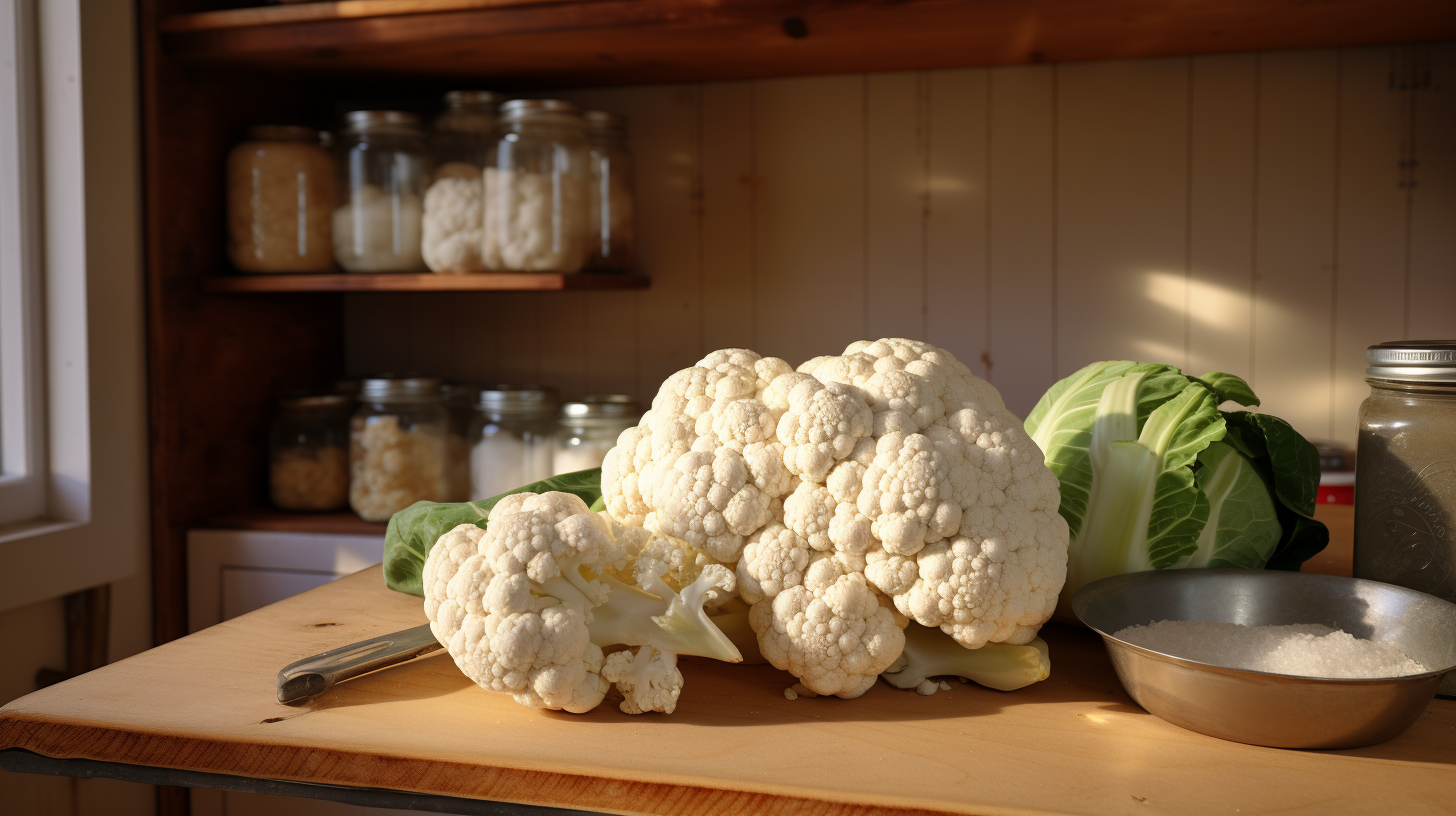So you’ve got a surplus of cauliflower and you’re wondering what to do with it all? Well, freezing cauliflower is a convenient and easy way to preserve its freshness for future use. Whether you want to extend the shelf life of your cauliflower, save it for a later recipe, or simply avoid waste, this article will provide you with a step-by-step guide on how to freeze cauliflower. By following these simple instructions, you’ll be able to enjoy this nutritious vegetable long after it’s out of season. So let’s get started and learn how to freeze cauliflower the right way!
Preparing the Cauliflower
Selecting the Cauliflower
When selecting cauliflower for freezing, it’s important to choose fresh, firm heads that have a vibrant, white color. Avoid cauliflower with brown spots or any signs of discoloration. Additionally, ensure that the leaves are crisp and green. Fresh cauliflower will freeze better and maintain its quality for a longer period of time.
Cleaning the Cauliflower
Before freezing cauliflower, it’s crucial to clean it thoroughly to remove any dirt, debris, or potential contaminants. Start by removing the outer leaves and trimming the stem. Rinse the cauliflower under cool running water, ensuring that all surfaces are clean. You can also soak the heads in a bowl of water for a few minutes to loosen any stubborn dirt.
Cutting the Cauliflower into Florets
To prep the cauliflower for freezing, you need to cut it into florets. Start by cutting off the florets from the central stem, ensuring they are roughly equal in size. You can break larger florets into smaller pieces if desired. Remember to discard any tough or woody stems. Once the cauliflower is cut into florets, it will be easier to blanch and freeze.
Blanching the Cauliflower
Boiling Water
Blanching cauliflower is a crucial step to preserve its texture, color, and nutrients during the freezing process. To blanch the cauliflower, you will need a large pot of boiling water. Fill a pot with water and bring it to a rolling boil over high heat. The pot should be large enough to accommodate the cauliflower florets comfortably.
Prepping an Ice Bath
While the cauliflower is blanching, it’s important to prepare an ice bath. This icy immersion serves to halt the cooking process and cool down the cauliflower quickly. Fill a large bowl or sink with cold water and add ice cubes to create a frigid bath. Make sure the ice bath is ready before blanching the cauliflower to ensure a smooth transition from boiling water to cooling.
Blanching the Cauliflower
To blanch the cauliflower, carefully lower the florets into the boiling water. Let them cook for about 2-3 minutes. Blanching times may vary slightly depending on the size of the florets, so it’s best to test for doneness by piercing a floret with a fork. Once the cauliflower is blanched, promptly remove the florets from the boiling water and transfer them to the prepared ice bath.
Cooling and Draining
Transferring to the Ice Bath
Once the cauliflower florets have been blanched, it’s essential to transfer them immediately to the ice bath. The ice bath rapidly cools down the cauliflower, halting the cooking process and preserving its crunchy texture. Allow the florets to sit in the ice bath for roughly 3-4 minutes, or until they are completely cooled.
Cooling Time
After the cauliflower has spent sufficient time in the ice bath, drain the florets thoroughly. Shake off any excess water and pat them dry gently using a clean kitchen towel or paper towels. It’s essential to remove excess water to prevent it from turning into ice crystals during freezing, which could affect the quality of the cauliflower.
Draining the Cauliflower
Once the excess water has been removed, transfer the drained cauliflower florets to a colander or sieve. Let them sit for a few minutes to ensure all remaining water has drained off completely. Properly draining the cauliflower helps maintain its individuality, especially when it comes time to portion and freeze it.
Packaging for Freezing
Choosing Container or Bags
When it comes to packaging cauliflower for freezing, you have two primary options: containers or freezer bags. Both have their advantages, so it ultimately comes down to personal preference. Containers offer better protection against crushing or flattening the cauliflower, while freezer bags are more space-efficient and provide an airtight seal.
Removing Excess Water
Before packaging the cauliflower, it is crucial to ensure that it is as dry as possible. Any remaining moisture can lead to freezer burn or affect the cauliflower’s texture. Use a clean kitchen towel or paper towels to gently pat the florets dry. This step is particularly important if you plan to use freezer bags, as excess moisture can cause them to stick together during freezing.
Portioning the Cauliflower
To make it easier to use later on, consider portioning the cauliflower before freezing. This way, you can thaw and use only the amount you need without compromising the quality of the remaining cauliflower. Divide the cauliflower into conveniently sized portions based on your usage preferences, such as per meal or recipe requirements.
Sealing and Labeling
Sealing the Containers/Bags
Whether you choose containers or freezer bags, it’s important to seal them tightly to prevent air from entering and causing freezer burn. For containers, ensure that the lids are properly closed and secure. If using freezer bags, squeeze out any excess air before sealing them tightly. An airtight seal is vital for preserving the flavor, texture, and quality of the frozen cauliflower.
Labeling with Date and Contents
To avoid confusion and ensure you use the oldest cauliflower first, label each container or bag with the date of freezing. Additionally, write down the contents, i.e., “Frozen Cauliflower,” on each label. Proper labeling helps keep track of when the cauliflower was frozen and simplifies meal planning, ensuring you can enjoy the cauliflower for an extended period without worrying about spoilage.
Considering Vacuum Sealing
Vacuum sealing is an additional option you may consider for freezing cauliflower. Vacuum-sealed bags remove air, providing an extra layer of protection against freezer burn. This method can help extend the shelf life of the cauliflower and preserve its quality over a more extended period. If you have a vacuum sealer at your disposal, it’s worth the extra step to maximize the cauliflower’s freezing potential.
Freezing the Cauliflower
Optimal Freezing Temperature
To ensure that the cauliflower freezes properly, set your freezer to the optimal temperature of 0°F (-18°C) or below. Maintaining a consistent and sufficiently cold temperature helps preserve the cauliflower’s texture, flavor, and nutritional value throughout its time in the freezer.
Placing in the Freezer
After properly packaging the cauliflower, place the containers or bags in the freezer. Arrange them in a single layer initially to allow for faster and more even freezing. Once the cauliflower is fully frozen, you can rearrange the storage as needed to maximize space utilization. Avoid overcrowding the freezer to ensure proper air circulation and maintain a consistent temperature.
Avoiding Overloading the Freezer
It’s crucial not to overload your freezer when freezing cauliflower or any other food items. Overcrowding the freezer restricts airflow and can lead to uneven freezing and potential temperature fluctuations. By leaving enough space between items, you can ensure optimal freezing conditions for your cauliflower and maintain the overall efficiency of your freezer.
Thawing and Using Frozen Cauliflower
Thawing Methods
When it’s time to use your frozen cauliflower, proper thawing is essential to preserve its taste and texture. The best method for thawing frozen cauliflower is to transfer the desired amount to the refrigerator the night before you plan to use it. Slowly thawing in the refrigerator allows the cauliflower to defrost evenly and helps retain its shape and quality. Alternatively, you can thaw cauliflower by placing it in a sealed bag in a bowl of cold water. Avoid thawing cauliflower at room temperature to minimize the risk of bacterial growth.
Cooking from Frozen
In some recipes, you may be able to use frozen cauliflower directly without thawing it beforehand. However, it’s important to note that the texture may differ slightly compared to using fresh or thawed cauliflower. Frozen cauliflower tends to be softer and more suitable for dishes like soups, stews, or stir-fries where texture is less critical.
Utilizing in Different Recipes
Frozen cauliflower can be used in various recipes, offering convenience and versatility. Add thawed cauliflower to casseroles, curries, or pasta dishes. You can even use it to make cauliflower rice, a low-carb alternative to traditional rice. Experiment with different recipes to see how frozen cauliflower can be incorporated into your favorite meals throughout the year.
Storing and Shelf Life
Proper Storage Conditions
Once frozen, cauliflower should be stored at a consistent and sufficiently cold temperature of 0°F (-18°C) or below. Ensure that the containers or bags are sealed tightly to prevent air and moisture from reaching the cauliflower. Stored correctly, frozen cauliflower can maintain its quality and flavor for an extended period.
Maximum Shelf Life
Frozen cauliflower can be stored for up to 10-12 months without significant loss in quality when properly stored. However, it’s best to consume it within the first 6-8 months to enjoy the cauliflower at its peak flavor and texture. Regularly check the cauliflower for any signs of freezer burn or deterioration and discard any affected portions.
Monitoring for Freezer Burn
Freezer burn can occur when the cauliflower is exposed to air, causing dehydration and the formation of ice crystals. To minimize the risk of freezer burn, ensure airtight packaging and regular checks for leaks or damaged containers. If you notice any signs of freezer burn, such as discoloration or a dry, shriveled appearance, it’s recommended to discard the affected parts.
Tips and Tricks
Blanching Alternatives
If you prefer not to blanch cauliflower, you can simply skip this step and freeze the florets raw. However, blanching helps maintain the cauliflower’s flavor, texture, and color for a longer period of time, making it a beneficial step to consider.
Seasoning Before Freezing
To add extra flavor to your frozen cauliflower, consider seasoning it before freezing. Sprinkle it with your favorite herbs, spices, or marinades before packaging and freezing. This way, the cauliflower will absorb the flavors during the freezing process, enhancing its taste when you use it in various dishes later on.
Freezing Cauliflower Rice
Cauliflower rice has gained popularity as a healthy and low-carb alternative to regular rice. If you have made cauliflower rice, you can freeze it by following the same blanching and freezing steps mentioned earlier. Portion it into meal-sized containers or bags for easier use in your future recipes.
Final Thoughts
Versatility of Frozen Cauliflower
Freezing cauliflower allows you to enjoy its delicious taste and numerous health benefits all year round. Whether you’re adding it to soups, stir-fries, or even making cauliflower rice, frozen cauliflower offers a convenient and versatile ingredient that can be used in various recipes to suit your culinary preferences.
Experimenting with Freezing
While the processes mentioned above are tried and tested methods for freezing cauliflower, don’t be afraid to experiment and find what works best for you. You might discover new techniques, such as combining blanched and raw florets, or different seasoning options that add a personal touch to your frozen cauliflower.
Enjoying Cauliflower All Year
By properly preparing and freezing cauliflower, you can enjoy this nutritious and versatile vegetable even when it’s out of season. With the right techniques and a bit of planning, you can savor the taste and benefits of cauliflower throughout the year, adding it to your favorite dishes and exploring new culinary creations. So go ahead, freeze some cauliflower and have it readily available whenever inspiration strikes!

